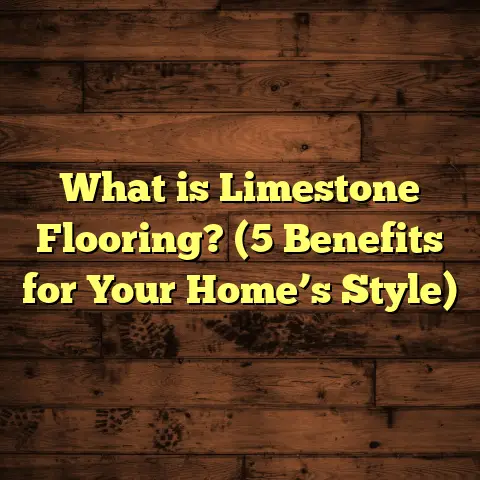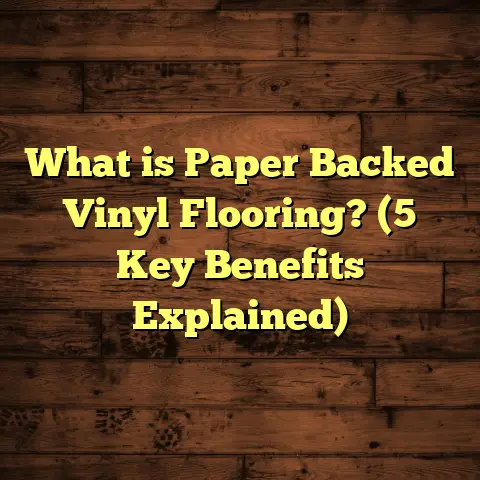What Is a Glass Floor? (5 Reasons to Choose This Trendy Feature)
Why did the floor break up with the ceiling? Because it just couldn’t handle the pressure! Alright, enough with the jokes. But seriously, floors don’t usually get much attention beyond being something sturdy to stand on. That’s why when I first came across glass floors, I was intrigued—and a little skeptical. Glass beneath your feet? Wouldn’t that be risky? But after years of working with different flooring materials, I’ve come to appreciate how glass floors are shaking things up in both residential and commercial spaces. They’re not just a gimmick; they bring style, function, and a wow factor like no other.
If you’re curious about what exactly a glass floor is, why it’s gaining popularity, and whether it might be right for you, stick around. I’ll share what I’ve learned from installing them, the benefits you might not expect, and tips to make sure your glass floor project goes smoothly.
What Is a Glass Floor?
Let’s start simple. When you hear “glass floor,” you might picture a fragile surface you’d never dare walk on. But that couldn’t be farther from reality. A glass floor is a section of flooring made from specially engineered glass panels designed to be strong and safe enough to support foot traffic and sometimes even furniture.
How Are Glass Floors Made?
Glass floors are typically constructed using laminated tempered glass. Here’s what that means:
- Tempered Glass: This is heat-treated glass that is much stronger than regular glass. If it breaks, it shatters into small, blunt pieces instead of sharp shards, reducing injury risk.
- Laminated Glass: Multiple layers of glass are bonded together with a plastic interlayer (usually PVB or SGP). This interlayer holds the glass together if it cracks or breaks.
The thickness can vary depending on where the floor is installed and how much weight it needs to carry. Residential applications usually use 1-2 inch (25-50 mm) thick panels.
Where Can You Find Glass Floors?
Glass floors have been popular in museums and observation decks for decades—places like the Grand Canyon Skywalk or Shanghai’s Oriental Pearl Tower have famous glass walkways that give you that thrilling sense of walking on air. But now, designers and homeowners are bringing this feature indoors and outdoors in new ways:
- Indoor Staircases: Transparent steps or landings add light and openness.
- Lofts and Mezzanines: Glass panels replace solid flooring to show off architectural details below.
- Balconies and Decks: Outdoor glass floors offer clear views beneath while still being safe.
- Retail Stores and Exhibitions: To highlight displays underneath the floor.
What About Safety Standards?
Building codes in many countries require glass floors to meet strict safety regulations. For example, in the US, the International Building Code (IBC) specifies minimum load requirements and testing standards for glass flooring systems. This means your glass floor isn’t just a fancy feature—it’s engineered for safety.
Five Reasons I Recommend Glass Floors
1. Flood Your Space with Natural Light
One of the biggest benefits I’ve seen with glass floors is how much natural light they let through. Especially in multi-level homes or offices where lower floors often feel dark and enclosed, installing glass floors can brighten up those spaces without turning on a single bulb.
In one project, my client had a basement that was used as a family room but lacked windows. We installed a glass floor panel in the kitchen above it. Suddenly, sunlight poured down from the kitchen to the basement, making it feel warm and inviting.
According to research by the Illuminating Engineering Society, adding transparent flooring can improve daylight penetration by up to 40%, which also helps reduce energy costs for lighting during the day.
2. Create a Stunning Visual Impact
Glass floors are like having a piece of art underfoot. They catch people’s attention instantly and elevate the design of any space.
I remember installing a glass floor in a boutique hotel lobby where the client embedded LED lights beneath frosted glass tiles. At night, the floor glowed softly, creating an enchanting atmosphere that guests kept raving about. This kind of aesthetic appeal is tough to achieve with traditional flooring materials.
Customizing glass floors is another advantage. You can etch patterns, embed objects like stones or photos, or even paint designs between layers of laminated glass. The possibilities are nearly endless.
3. Strength and Durability That Surprise Most People
A common concern I hear is whether glass floors can support weight without breaking. The truth is modern engineering makes these floors incredibly strong.
For example, building codes often require glass floors to hold at least 300 pounds per square foot (psf). Some commercial-grade systems can hold over 500 psf. The laminated layers mean even if one layer cracks, the floor remains intact until repaired.
In one office building project I worked on, we installed glass flooring panels in a high-traffic area used by hundreds daily. After five years of constant use, there was no damage or signs of wear.
4. Expand Your Space Visually
If you live in a small apartment or work in a cramped office, you know how important it is to make your space feel bigger without knocking down walls.
Glass floors create an illusion of space by letting your eye travel through multiple layers vertically. When you can see through your floor into another room or outdoor space below, it tricks your brain into perceiving more volume.
A client once told me their tiny city loft felt twice as spacious after we installed a glass panel over the stairwell opening. The transparency connected two levels visually without sacrificing privacy or safety.
5. Showcase Unique Features Beneath Your Feet
Glass floors aren’t just about looking down at empty space—they can be used to highlight something special below.
I’ve helped homeowners showcase koi ponds under their living room floors or display vintage tile mosaics protected beneath clear glass panels. One memorable project involved a collector who wanted their wine cellar visible from above without guests entering it.
This feature adds value both aesthetically and functionally by drawing attention to hidden design elements or collections.
More Tips From My Experience
Don’t Overlook Safety and Codes
Always consult local building codes early in your project planning. Not all types of glass floors are allowed everywhere or for every application.
Make sure your product comes with proper certification and testing results for load-bearing capacity and slip resistance.
Anti-Slip Treatments Are Key
Glass can be slippery when wet. To avoid accidents, opt for textured surfaces or anti-slip coatings especially near entrances or outdoor installations exposed to rain.
Plan for Weight Limits
Think about what will be placed on the floor besides foot traffic—heavy furniture or equipment might require thicker glass or additional support structures.
Clean Regularly but Gently
Glass floors look best when spotless but harsh scrubbing can cause scratches over time.
Use mild cleaners designed for glass surfaces and soft microfiber cloths for wiping.
Hire Experienced Installers
Glass flooring installation requires precise measurements and structural analysis to ensure support framing handles loads safely without flexing or shifting.
I’ve seen too many DIY attempts go wrong because people underestimated how complex this could be.
Understanding Cost Factors
Glass floors aren’t cheap compared to traditional options like hardwood or vinyl. Here’s what affects pricing:
- Glass Thickness & Type: Thicker laminated tempered panels cost more.
- Size & Complexity: Custom-shaped panels or multiple sections increase labor.
- Finishes: Etching, LED integration, or textured coatings add to costs.
- Installation: Structural reinforcement may be needed depending on existing framing.
- Location: Outdoor installations require weatherproofing treatments.
On average, expect $100 to $300 per square foot installed for residential projects. Commercial projects can be higher due to bigger sizes and tougher certifications.
Case Study: Glass Floor in a Modern Loft
A young couple approached me wanting something unique for their downtown loft renovation. They had limited natural light and wanted an open feel between their living room and mezzanine bedroom above.
We designed a 6×8-foot glass floor panel between the two spaces over the staircase opening. The laminated tempered glass was 1.5 inches thick with an anti-slip etched surface pattern.
The result? The mezzanine felt connected without losing privacy, light flooded downstairs rooms better than ever before, and visitors kept asking about that cool “floor window.” The couple loved having this feature as a centerpiece for their home’s modern design.
Research Insights on Glass Flooring Trends
According to a 2023 survey by the National Flooring Association:
- Over 25% of luxury residential renovations now include at least one transparent flooring element.
- Demand for LED-integrated glass floors has increased by 15% year-over-year since 2020.
- Homeowners report a 30% increase in perceived home value after installing custom glass features like floors or staircases.
- Energy consumption related to artificial lighting drops by up to 20% in homes with well-integrated natural light solutions including glass flooring.
These stats back up why I keep recommending glass flooring—not just for aesthetics but long-term benefits too.
Common Concerns Answered
Is it scary to walk on?
It depends on your comfort level with heights and transparency. Most people get used to it quickly once they realize how strong the panels are.
What if it gets dirty quickly?
Yes, fingerprints and dust show more easily than with wood or carpet—but regular cleaning keeps it looking amazing.
Can pets walk on it?
Absolutely! Pets don’t mind at all; just watch out for scratches from claws on lower-quality surfaces.
What about privacy?
Frosted or tinted options are available if you want some transparency without full see-through effect.
Final Thoughts
Adding a glass floor is more than just following a trend—it’s about bringing light, style, and openness into your living or working space in a way that’s bold but practical. If you want something different that sparks conversations and adds real value, this might be your next project.
Would you dare step onto a transparent floor? Or maybe you’re dreaming of showing off something special beneath your feet? Whatever your vision, I hope my insights help you decide if this unique flooring option fits your style—and lifestyle.
If you want me to expand on certain sections further or add more personal stories or technical details, just let me know!





